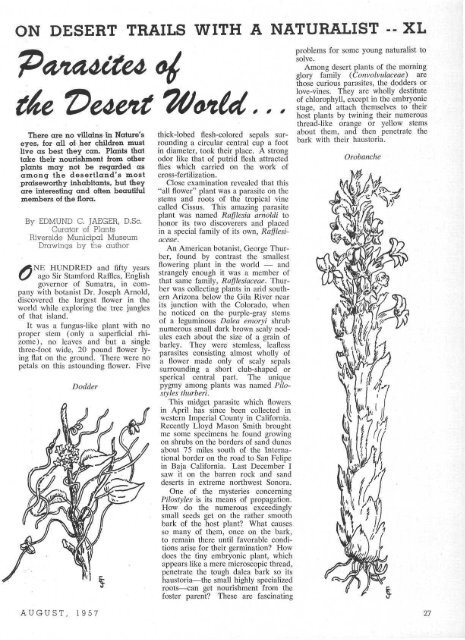1 - Desert Magazine of the Southwest
1 - Desert Magazine of the Southwest
1 - Desert Magazine of the Southwest
Create successful ePaper yourself
Turn your PDF publications into a flip-book with our unique Google optimized e-Paper software.
ON DESERT TRAILS WITH A NATURALIST -- XL<br />
Parasites <strong>of</strong><br />
<strong>the</strong> <strong>Desert</strong> World ...<br />
There are no villains in Nature's<br />
eyes, for all <strong>of</strong> her children must<br />
live as best <strong>the</strong>y can. Plants that<br />
take <strong>the</strong>ir nourishment from o<strong>the</strong>r<br />
plants may not be regarded as<br />
among <strong>the</strong> desertland's most<br />
praiseworthy inhabitants, but <strong>the</strong>y<br />
are interesting and <strong>of</strong>ten beautiful<br />
members <strong>of</strong> <strong>the</strong> flora.<br />
By EDMUND C. JAEGER, D.Sc.<br />
Curator <strong>of</strong> Plants<br />
Riverside Municipal Museum<br />
Drawings by <strong>the</strong> author<br />
HUNDRED and fifty years<br />
ago Sir Stamford Raffles, English<br />
governor <strong>of</strong> Sumatra, in company<br />
with botanist Dr. Joseph Arnold,<br />
discovered <strong>the</strong> largest flower in <strong>the</strong><br />
world while exploring <strong>the</strong> tree jungles<br />
<strong>of</strong> that island.<br />
It was a fungus-like plant with no<br />
proper stem (only a superficial rhizome),<br />
no leaves and but a single<br />
three-foot wide, 20 pound flower lying<br />
flat on <strong>the</strong> ground. There were no<br />
petals on this astounding flower. Five<br />
Dodder<br />
thick-lobed flesh-colored sepals surrounding<br />
a circular central cup a foot<br />
in diameter, took <strong>the</strong>ir place. A strong<br />
odor like that <strong>of</strong> putrid flesh attracted<br />
flies which carried on <strong>the</strong> work <strong>of</strong><br />
cross-fertilization.<br />
Close examination revealed that this<br />
"all flower" plant was a parasite on <strong>the</strong><br />
stems and roots <strong>of</strong> <strong>the</strong> tropical vine<br />
called Cissus. This amazing parasite<br />
plant was named Rafflesia arnoldi to<br />
honor its two discoverers and placed<br />
in a special family <strong>of</strong> its own, Rafflesiaceae.<br />
An American botanist, George Thurber,<br />
found by contrast <strong>the</strong> smallest<br />
flowering plant in <strong>the</strong> world — and<br />
strangely enough it was a member <strong>of</strong><br />
that same family, Rafflesiaceae. Thurber<br />
was collecting plants in arid sou<strong>the</strong>rn<br />
Arizona below <strong>the</strong> Gila River near<br />
its junction with <strong>the</strong> Colorado, when<br />
he noticed on <strong>the</strong> purple-gray stems<br />
<strong>of</strong> a leguminous Dalea emoryi shrub<br />
numerous small dark brown scaly nodules<br />
each about <strong>the</strong> size <strong>of</strong> a grain <strong>of</strong><br />
barley. They were stemless, leafless<br />
parasites consisting almost wholly <strong>of</strong><br />
a flower made only <strong>of</strong> scaly sepals<br />
surrounding a short club-shaped or<br />
sperical central part. The unique<br />
pygmy among plants was named Pilostyles<br />
thurberi.<br />
This midget parasite which flowers<br />
in April has since been collected in<br />
western Imperial County in California.<br />
Recently Lloyd Mason Smith brought<br />
me some specimens he found growing<br />
on shrubs on <strong>the</strong> borders <strong>of</strong> sand dunes<br />
about 75 miles south <strong>of</strong> <strong>the</strong> International<br />
border on <strong>the</strong> road to San Felipe<br />
in Baja California. Last December I<br />
saw it on <strong>the</strong> barren rock and sand<br />
deserts in extreme northwest Sonora.<br />
One <strong>of</strong> <strong>the</strong> mysteries concerning<br />
Pilostyles is its means <strong>of</strong> propagation.<br />
How do <strong>the</strong> numerous exceedingly<br />
small seeds get on <strong>the</strong> ra<strong>the</strong>r smooth<br />
bark <strong>of</strong> <strong>the</strong> host plant? What causes<br />
so many <strong>of</strong> <strong>the</strong>m, once on <strong>the</strong> bark,<br />
to remain <strong>the</strong>re until favorable conditions<br />
arise for <strong>the</strong>ir germination? How<br />
does <strong>the</strong> tiny embryonic plant, which<br />
appears like a mere microscopic thread,<br />
penetrate <strong>the</strong> tough dalea bark so its<br />
haustoria—<strong>the</strong> small highly specialized<br />
roots—can get nourishment from <strong>the</strong><br />
foster parent? These are fascinating<br />
problems for some young naturalist to<br />
solve.<br />
Among desert plants <strong>of</strong> <strong>the</strong> morning<br />
glory family (Convolvulaceae) are<br />
those curious parasites, <strong>the</strong> dodders or<br />
love-vines. They are wholly destitute<br />
<strong>of</strong> chlorophyll, except in <strong>the</strong> embryonic<br />
stage, and attach <strong>the</strong>mselves to <strong>the</strong>ir<br />
host plants by twining <strong>the</strong>ir numerous<br />
thread-like orange or yellow stems<br />
about <strong>the</strong>m, and <strong>the</strong>n penetrate <strong>the</strong><br />
bark with <strong>the</strong>ir haustoria.<br />
Orobanche<br />
AUGUST, 1957 27

















